Peru
Country statistics

Land area: 494,208 sq miles (1,279,999 sq km)
Total area: 496,223 sq miles (1,285,220 sq km)
Population (2011 est.): 29,549,517 (growth rate: 1.02%); birth rate: 19.13/1000; infant mortality rate: 21.5/1000; life expectancy: 72.73
Capital City: Lima
Monetary unit: Nuevo sol (1991)
Languages: Spanish, Quéchua (both official); Aymara; many minor Amazonian languages
Ethnicity/race: Amerindian 45%, mestizo 37%, white 15%, black, Japanese, Chinese, and other 3%
Religions: Roman Catholic 81.3%, Evangelical 12.5%, other%, unspecified or none 2.9% (2007 est.)
Country introduction

Peru is a country in western South America. It is bordered on the north by Ecuador and Colombia, on the east by Brazil, on the south-east by Bolivia, on the south by Chile, and on the west by the Pacific Ocean.
Peru is South America's third largest country, covering 1,285,215 sq km (798,596 sq miles), and can be divided into three distinct geographic regions. The lowland coastal region to the west, the central highlands and the tropical jungles of the Amazon Rainforest to the east.
The narrow coastal strip makes up 10% of Peru, which stretches for 2,414 km (1,500 miles) and consists mainly of desert with some beautiful beaches and fertile valleys. It merges at its southern end into the Atacama Desert, one of the driest places on earth. Since about 40 rivers flow from the Andes into the coast, there are many fertile and green places in the desert region where several major cities have formed including Lima, the capital, Trujillo, and Chiclayo.
The central highlands is the region of the Andes, the backbone of the country that separates the coast from the tropical jungles. It consists of massive peaks, steep canyons, and extraordinary pre Columbian archaeological sites. It is also the longest mountain range in the world and second highest, next to the Himalayas. Its highest point, Cerro Aconcagua, is found in Argentina, but in the Peruvian Andes the highest peak, Huascarán Sur, tops off at 6,766 m (22,200 ft). The Andes cover the length of 7 countries, beginning in Venezuela and extending through parts of Colombia, Ecuador, Peru, Bolivia, Chile and Argentina. The Andes are still one of the world's most unstable mountain ranges, with frequent earthquakes, landslides, and flash floods. Despite such instability, the Andes are also the site of the most fascinating pre-Columbian cities of South America, like the great city of the clouds, Machu Picchu. Some of the animals that can be found in the Andes include the llama, puma which was very important in the Incan culture, the condor which is a very rare bird, deer, and foxes. Also located in the Andes is Lake Titicaca, which is about 563 km (350 miles) long and 160 km (100 miles) wide. It is so large that it has waves like a sea. It is used by the people as a trade route with Bolivia.

Peru's third great region is the dense forest that surrounds the headwaters of the Amazon beneath the eastern slopes of the Andes. It represents more than half of the country and surrounds the wide and winding Amazon River. This part of the country is so inaccessible that only the most adventurous and intrepid travelers should attempt to penetrate its mysterious emerald depths. In fact, the region's capital of Iquitos, a city of 400,000, is only accessible by air or by boat up the Amazon. There are thousands of different species of plants and animals here including jaguars, snakes, colorful birds, and piranhas.
The main rivers of Peru include the Ucayali, Marañon, Amazon (which is formed by the confluence of the Marañon and the Ucayali), Putumayo, Pastaza, Napo, Jurua, and the Purus.
The culture

Peru was inhabited by various tribal peoples throughout most of its ancient history. In the 12th century the small city state of Cuzco was formed from a tribe of the Killkes by the leader Manco Capac. This was the start of the Inca Empire. Over the next several hundred years the Inca Empire would expand to conquer Peru, much of Ecuador, parts of Bolivia, and Northern Chile. The Inca civilization was highly developed when the Spanish arrived in 1531.
Spanish Conquistador Francisco Pizarro conquered the Incas and captured Cuzco in 1533. The Spanish soon discovered gold and silver in the Andes Mountains and Peru became a great source of Spanish wealth and power. In 1535 Francisco Pizarro established the city of Lima. Lima became the capital of the area and is a major world city to this day. Peru declared independence in 1821. With the help of South American liberation heroes Jose de San Martina and Simon Bolivar, Peru was able to defeat the Spanish and become a free country.
Peru's population of about 23 million is divided between the highlands and the coast. The highland regions are poor farmers, while the fertile river valleys of the lowlands have produced a wealthier, more cosmopolitan culture.
Art prior to Spanish colonization concentrated upon fine ceramics, metalwork, stone craft and textiles. The Spanish subsequently introduced planned cities laid out in blocks, and constructed mansions, churches and monasteries which mimicked renaissance or early baroque. Over time, a native Indian influence developed, leading to a style known as Mestizo. A distinctive Cusco painting style developed, in which artists turned their attention away from the visible world, and concentrated instead on fairytale and fable.
Peruvian music is almost entirely folk music, especially in the Andes, with African influences around Lima. Its literature covers everything from chronicles of the conquest, independence-inspired poets to the internationally renowned author Mario Vargas Llosa. The main religion is Roman Catholicism, though Catholicism blends with traditional beliefs.
Typical Peruvian dishes are tasty and vary regionally. Seafood is, understandably, best on the coast, while the Inca delicacy such as roast guinea pig can be sampled in the highlands. Other dishes include the lomo saltado (chopped steak fried with onions), cebiche de corvina (white sea bass marinated in lemon, chili and onions, often served cold with a boiled potato or yam), and sopa a la criolla (a lightly spiced noodle soup with beef, egg, milk and vegetables). A local spirit forms the basis of the cocktail 'Pisco Sour'.
Fiestas are a part of life throughout Peru. Any religious or pre-Christian feast day is an excuse for live music, wearing elaborate costumes and consuming vast quantities of alcohol. Sometimes the fiestas last for days or weeks. Sometimes they involve throwing water, flour or other missiles at each other. There are numerous regional festivals. The most notable is Carnival week that usually takes place in February. The usual hum-drum life in the dusty altiplano (Spanish for high plain) is transformed by the costumes, music and incessant dancing. The holidays usually are usually associated with a harvest festival or giving thanks to the sun and rain gods. The costumes depict mythological themes or poke fun at the Spanish who tried to wipe out the Indian culture.
Attractions & landmarks

Peru's most popular tourist attraction is to be found in the majestic mountains of the Andes. The Andes Mountains are not just known for its splendor and beauty, but also for the rich history that is held within the peaks and valleys of this vast region. Points of interest are in the ancient cities where the Inca Empire established its civilization. The most famous city is Machu Picchu, once the city of some of the more elite Inca's, and now one of the Seven Wonders of the World. There is an Inca Trail that can be hiked to get to this well preserved city of ancient ruins. Within the trail is the Sacred Valley which holds much of the Inca history with all of its ruins still intact. Another great trekking experience can be had at the Huascaran National Park, which is located in the White Mountain Range, Cordillera Blanca. Mountain climbing, some limited snow skiing and horseback riding are some of the activities that the park has to offer. It is also from here that tourists can visit the Alpamayo Mountain, which was named the most beautiful mountain in the world, by the UNESCO. The Andes Highlands is home to the city of Arequipa, some 2,359 m (7,740 ft) above sea level and is known for its incredible Volcanoes. The Misti volcano can be climbed very easily, not needing any type of equipment. Colca Canyon is also a trip worth taking to observe the deepest canyon in the world. Trips down the rapids in the canyon's rivers, or even an extended trek down to the Amazon Rainforest can also be taken. Cusco is an ideal city to visit and tours can be booked to take from the mountain tops to the lush jungles. From Arequipa and Cusco, visitors can travel south-east to the town of Puno, located along the shores of Lake Titicaca, 3,657 m (12,000 ft) up into the Andes.

The Nazca Lines are located between the towns of Nazca and Palpa along the Northern Pacific coast. Created between 200 BC and 700 AD the figures range from simple lines to stylized spiders, monkeys, fish, llamas, lizards and human figures. The lines were created on such a large scale that it wasn't until the 1920s, when Peruvian airlines started to fly from Lima to Arequipa, that they were recognized as figures. Hotels and tour agents in Nazca offer round flights in a Cessna to view the lines. There is also an observation tower along the Pan-American highway with a view of three of the figures. Also, on the northern coast, Máncora is a small town featuring Peru's best sandy beach, stretching for several kilometers along the Pacific. The town also boasts a large proportion of beach resorts, luxury restaurants and nightclubs for such a small town where the Pan-American Highway serves as the town's main street. The consistently good waves makes Mancora a popular surfing destination while a raucous nightlife keeps visitors busy after the sun disappears.
According to some, the Peruvian Amazon jungle is a better adventure holiday destination than its Brazilian counterpart around Manaus, with basically the same wildlife but less spoilt and better value. Starting point to an Amazon boat tour in Peru is Iquitos, the world's largest city that cannot be reached by road. That leaves planes and boats as the primary means of entrance and exit for both people and supplies.